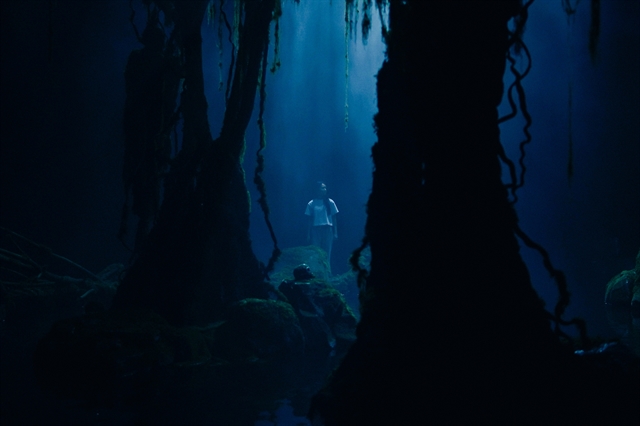Most Vietnamese films today feature grand scenes to meet audience expectations and serve promotional purposes.

The upcoming film 'Dưới Đáy Hồ' (The Lake), to be released on June 6, has two large-scale, visually impactful scenes. Photo nld.com.vn
HCM CITY Most Vietnamese films today feature grand scenes to meet audience expectations and serve promotional purposes.
In filmmaking, a "grand scene" typically refers to a scene designed to be visually impressive and impactful, often involving large-scale elements or elaborate sets.
These grand scenes not only need to be large-scale and unique, but also demand creativity from the filmmakers. They must deliver visually striking moments that captivate viewers.
If done haphazardly and without relevance to the storyline, these scenes become ineffective and a costly waste for filmmakers.
In a film, the number and design of grand scenes depend on the budget, script, and genre.
Horror or social-romantic films typically require fewer grand scenes, focusing only on key moments that need emphasis.
However, for action or adventure films, the more grand scenes, the better.
Time- and cost-consuming
To create a suitable grand scene, the production team must invest significant time and effort in scouting locations, designing, and staging scenes that are both creative and engaging while ensuring safety.
Director Trần Hữu Tấn said that in his upcoming film Dưới Đáy Hồ (The Lake), releasing on June 6, his team produced two grand scenes.
Each required two full days of preparation, followed by casting and rehearsing with both lead and background actors before filming began.
“Creating grand scenes is often expensive due to the large number of background actors involved, who must be compensated. Preparations must be thorough to ensure safety. The director and crew must closely monitor every detail, ensuring everything is perfectly placed. Post-production also takes considerable time and budget, as any misplaced or unscripted elements must be edited out,” Tấn told Người Lao Động newspaper.
In the Lật Mặt (Face Off) film series, director Lý Hải and his team have invested heavily in grand scenes to create standout moments.
In the latest installment, Lật Mặt 8: Vòng Tay Nắng (Face Off 8: Embrace of Light), an explosion scene was captured using five cameras, three main cameras and two drones.
To preserve realism, the scene was filmed live with minimal use of CGI.
Safety experts were brought in to ensure both safety and visual impact.
For the dam-break flood scene in the same film, the crew spent 14 days designing and executing it.
They often had to submerge themselves in water at Nha Trinh Dam, Ninh Thuận Province.
“We scouted many locations because the scene needed visuals of both rising and receding water,” Hải said.
Eventually, they selected Nha Trinh Dam, which is nearly 500 metres long, five metres high, and three metres wide.
During the shoot, filming was frequently interrupted due to rising water, which at times swept away lighting equipment.
To ensure safety, the crew enlisted around 10 stunt performers, who were equipped with life jackets and ready to step in when necessary.
Dedication

MOVIEMAKERS: The crew of the film 'Dưới Đáy Hồ' (The Lake), which will be released on June 6. The movie has two large-scale, visually impactful scenes. Photo courtesy of Thanh Duy Sài Gòn FC
Grand scenes often comes with stories of difficulty and pressure from directors. However, a film without grand scenes struggles to impress audiences, unless it has a uniquely strong script.
“Grand scenes enhance a film’s value. They reflect the level of investment. Though costly and creatively demanding, filmmakers are willing to take on the challenge to satisfy the audience," Tấn said.
"When viewers watch a spectacular, well-integrated grand scene, they feel thrilled, and it justifies the price of admission.”
Director Kay Nguyễn emphasised that grand scenes are essential for many cinematic works. They’re often chosen for marketing materials to attract audiences. With an impressive grand scene, viewers are more inclined to buy tickets.
In many developed film industries, great emphasis is placed on producing grand scenes. Production teams willingly spend large budgets and significant effort to create jaw-dropping cinematic moments.
While Việt Nam’s film industry may not yet match the level of investment seen elsewhere, domestic filmmakers are increasingly paying attention to the creation of grand scenes to make their work more compelling.
This is a positive sign, and audiences can look forward to more heartfelt, meticulously crafted grand scenes in upcoming Vietnamese films. VNS